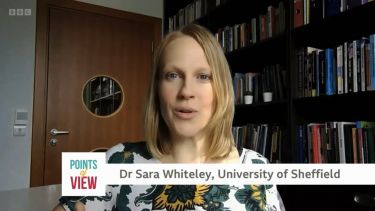‘The fourth wall’ is a metaphor for the invisible stage boundary separating actors from audience in the theatre, and is also used to refer to the boundary (of time, space and technology) between on-screen actors and viewers in TV and cinema.
When the fourth wall is ‘broken’, the characters seem to acknowledge the viewers’ presence as spectators. Recently this has become particularly prominent in television dramas, in shows such as House of Cards (Netflix), Fleabag (BBC) and Chewing Gum (Channel 4).
Stylistically breaking the fourth wall is really interesting as it doesn't have a single effect - it can be put to lots of different uses. Essentially it is used to position the viewer in relation to the characters by giving them information or perspectives that they wouldn't otherwise have.
The direct address can make us feel closer to the characters, fostering viewers’ empathy by giving us special access to the fictional world, or it can be used to put viewers in more distanced and uncomfortable positions – sometimes it achieves all of these at once!
Direct address and it’s uses in Annika
Annika is a new drama produced by BBC that invites viewers to join a detective on a high stakes journey to solve murders on Glasgow’s docklands. Dr Sara Whiteley shares some insights and interesting comparisons with how the technique is used in Annika and other dramas.
(credit - BBC)
“The direct address in Annika is not the most innovative use of direct address that I’ve seen – for instance, in Fleabag there is a shift in the way viewers are positioned as the show goes on – at first the direct address creates a sense of intimacy with Fleabag, but then we gradually seem to become an unwanted part of Fleabag’s psyche intruding upon her. This kind of play with the viewers is not present in Annika, but the technique does create some interesting effects nonetheless.”
“Annika’s first line in the show is “Call me Annika”, and from then the viewer becomes her confidant – we get information about the world of the story that others don’t have, including access to Annika’s emotions, vulnerabilities and secrets, and a sense of how her mind works, which generates both empathy and humour.”
“However, the information we glean about Annika could also be distancing – she uses literary allusions (e.g. to Shakespeare plays and Moby Dick) to think through relationships in the world around her, both when she is trying to solve crimes and in her private life – and this could be received as rather pretentious! She also makes quite rubbish jokes and is quite irresponsible at times (e.g. she skives off a work leadership course for a mini break).”
“Both these sides of Annika’s character are communicated via the direct address, so she comes across as unique and sympathetic but not always straightforwardly likeable. There are links to other female lead characters in shows such as Fleabag and Chewing Gum here, who are also presented as complex, flawed and ethically problematic via their talk to camera.”
(credit - simkl.com)
(Credit - themoviedb)
What does this mean for the viewer?
From Dr Whiteley’s research, comments and feedback from the Points of View interviewees there is a vast sway of opinions on this technique and its impact on the viewing experience. Sara analyses in more detail:
“Shows which break the fourth wall make for quite a different viewing experience – they can be quite provocative -- because viewers are asked to enter into an active relationship with the character, where she discloses things directly to us and we have to decide what to do with them.”
Whether or not this is a technique that makes you sit on the edge of your seat or reach for the remote is part of the ongoing debate and what makes this an intriguing way of enhancing the viewing experience. But one final thought from Sara is that this method evokes strong positive or negative emotions for viewers when used and this will be intriguing to see as we watch Annika play out.
If you’d like to learn more about Dr Sara Whiteley’s work and watch the full clip please see the links below.
Video clip - https://learningonscreen.ac.uk/ondemand/index.php/clip/236369
Research - https://journals.sagepub.com/doi/pdf/10.1177/0963947020983202




